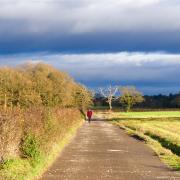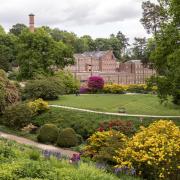Chester Zoo CEO Jamie Christon tells Jade Wright how funds raised by a new hotel and wedding venue will safeguard animals and their habitats at home and abroad
Chester Zoo is one of the world's leading conservation organisations, running breeding programmes and projects around the globe. It saves wild animals by protecting their habitats, as well as through education and science schemes. But its most significant single conservation area is here in Cheshire, rewilding a 10-mile stretch of land connecting Chester and Ellesmere Port.
‘The work we do across the world is hugely important, but I don’t know how many of our visitors are aware of what we do on our doorstep,’ says Jamie Christon, the zoo’s chief executive.

‘Our biggest conservation project is here in Cheshire. We’ve been working on UK native species focused conservation for more than a decade, with a nature reserve to support Cheshire’s ecosystems.’
The zoo team has also worked to transform its broader estate for wildlife and supports conservation projects across the North West of England and Wales.
In 2021 the work was awarded a grant by the Green Recovery Challenge Fund to transform, improve and create habitats across a 10-mile stretch. This includes supporting hedgerows to provide a mix of shelter and food for wildlife, orchards with deadwood, where invertebrates and fungi can find a home, while also providing nesting opportunities for birds and bats.

The zoo has already planted 30 young native apple and pear trees, with plans for at least 30 more Cheshire heritage varieties.
Ponds are one of the easiest and most effective ways to provide for wildlife. The zoo is building new ponds and managing old ones to make sure they continue to flourish as valuable habitat.
Jamie says: ’There is so much, right here on our doorstep, and we want to celebrate that and encourage the biodiversity in the zoo and in the area all around, as well as working with partners in countries around the world to make that happen overseas too.’
This all takes money – not to mention feeding and taking care of more than 35,000 animals on a 130-acre main zoo site.
So, as well as the revenue raised by ticket sales and annual passes, there’s a focus on events such as the Lanterns, which brings in additional visitors each December and increasing the number of corporate events and events such as weddings and functions.

‘The new 380-capacity wedding destination opens soon, and then there’s the hotel,’ says Jamie. ‘The two will work hand in hand and they give visitors the chance to see a bit more of the zoo, and wake up overlooking the giraffes, with all the sights and sounds they offer.’
The wedding and events site has a private courtyard and large windows overlooking the zoo’s botanical gardens and a host of historical features.
The hotel aims to offer a taste of the African savannah with lodge-style accommodation overlooking the new Heart of Africa zone. Both will open in the next few months, and it is hoped the revenues they raise will fund more conservation projects.
The zoo has launched a 10-year Conservation Masterplan. One of its key aims is to preserve species populations in the wild and in zoos and breeding centres through research, conservation breeding, welfare and monitoring.
Jamie has recently returned from Africa, where he’s been on a wildlife preservation mission, meeting new partners and finding ways to spread the work of the zoo to more of the animals’ natural habitats, protecting the wild population. ‘We have the opportunity to make a real difference,’ he says. ‘It’s about making sure we grab that chance and make the most of it.’

Chester Zoo has a pioneering breeding programme, supporting the populations of some of the world’s rarest species. Here are some of the animals born over the past 12 months.
Western chimpanzee
In January ZeeZee – a critically endangered Western chimpanzee – safely delivered a tiny baby boy following an eight-month pregnancy. The new male arrival is in good health and has spent the first few weeks of life bonding with mum and the rest of the 22-strong troop.
As few as just 18,000 Western chimpanzees remain across Africa and it is the first subspecies of chimpanzee to ever be declared critically endangered by the International Union for the Conservation of Nature.
Malayan tapir
Last November, a female calf, named Nessa, arrived to parents Margery (10) and Betong (10) in the early hours, weighing just 9kg. It followed a 13-month-long pregnancy. Chester is one of just two British zoos currently caring for the Malayan tapir, a species listed as endangered on the red list of threatened species. Fewer than 2,500 are estimated to remain across Malaysia, Sumatra, Thailand and Myanmar, with hunting, illegal logging and mass deforestation blamed for a decline in numbers, which has seen more than half of the world’s Malayan tapirs lost in the last 40 years.
One-horned rhino
A female greater one-horned rhino calf was born to Asha after a 16-month pregnancy last October. The species was once found roaming across the entire northern part of the Indian subcontinent but is now only present in a small area in India and Nepal. Listed as vulnerable to extinction on the red list of threatened species, there are only around 3,000 greater one-horned rhinos estimated to be left in the wild as they battle illegal poaching for their horns and habitat loss.
Parson’s chameleon
A group of 10 chameleons emerged from their eggs back in October. Parson’s chameleons currently hold the record for the longest incubation period of any reptile, making up to around two years. The first of the rare hatchlings arrived measuring just 2cm long and weighing just 1.5 grams following a 569-day incubation period. They will grow to be around 70cm and 800 grams.
The Parson’s chameleon population has declined by more than 20 per cent in the past two decades as a result of widespread habitat loss on the island of Madagascar. Experts believe the reptiles are unlikely to survive without drastic intervention.
Fossa
Last September, Chester Zoo announced the birth of a rare trio of fossa triplets for the first time in its 91-year history. The 12-week-old pups emerged from their den having been tucked away by their parents Shala and Isalo for the first few weeks of their lives. A distant relative of the mongoose, the fossa is a slender, cat-like mammal. It’s only found in the forests of Madagascar, where it’s the top predator.
The fossa is highly threatened as a result of widespread habitat loss in Madagascar. Scientists report that the island has already lost up to 90 per cent of its forests, which means that many species are now on the very brink of extinction. Recent estimates suggest as few as 2,600 remain in the wild.
Giraffe
Stanley the giraffe was born falling more than two metres onto a bed of soft straw in the early hours of August 6. This brought an end to a 15-month-long pregnancy for 14-year-old mum, Orla. Keepers named the new male calf Stanley after Mount Stanley, the tallest mountain in Uganda, where the zoo’s conservationists are fighting to boost giraffe numbers. The zoo’s team of giraffe experts has been helping the Giraffe Conservation Foundation and the Uganda Wildlife Authority, to protect giraffes in the wild. Two decades ago the number of giraffes in Kidepo Valley National Park was in single digits, but with these conservation efforts, it’s now a protected reserve that’s home to more than 70 adult Rothschild’s giraffes, with calves being born year on year.
Humboldt penguin
Nine penguin chicks hatched at the zoo last July. Weighing in at just 80g when they hatch, penguin chicks triple in size in their first three weeks of life and quickly reach around 3kg, just like their parents. Found on the rocky coastal shores of Peru and Chile, Humboldt penguins are one of the world’s most endangered penguin species. They are listed as vulnerable to extinction and face a number of threats including climate change, over-fishing, and rising acidity and temperature levels in the oceans.
Red-bellied lemur
Mum Aina gave birth to the zoo’s first set of red-bellied lemur twins in April last year. The tiny primates weighed just 70 grams each and spent the first few months of life clinging to mum and riding around on her back. They are some of the world’s rarest primates with their numbers having declined by more than 30 per cent in recent years. An international conservation-breeding programme involving some of the world’s leading zoos is now playing a vital role in the efforts to secure the species’ future.



























